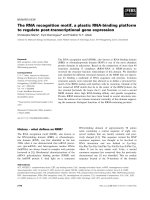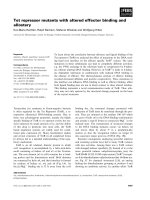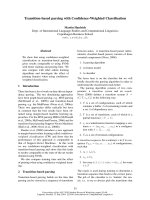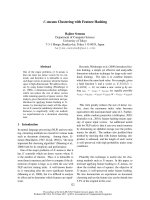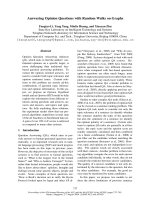Báo cáo khoa học: "Speech emotion recognition with TGI" pot
Bạn đang xem bản rút gọn của tài liệu. Xem và tải ngay bản đầy đủ của tài liệu tại đây (426.3 KB, 7 trang )
Proceedings of the EACL 2009 Student Research Workshop, pages 54–60,
Athens, Greece, 2 April 2009.
c
2009 Association for Computational Linguistics
Speech emotion recognition with TGI+.2 classifier
Julia Sidorova
Universitat Pompeu Fabra
Barcelona, Spain
Abstract
We have adapted a classification approach
coming from optical character recognition
research to the task of speech emotion
recognition. The classification approach
enjoys the representational power of a syn-
tactic method and efficiency of statisti-
cal classification. The syntactic part im-
plements a tree grammar inference algo-
rithm. We have extended this part of the
algorithm with various edit costs to pe-
nalise more important features with higher
edit costs for being outside the interval,
which tree automata learned at the infer-
ence stage. The statistical part implements
an entropy based decision tree (C4.5). We
did the testing on the Berlin database of
emotional speech. Our classifier outper-
forms the state of the art classifier (Multi-
layer Perceptron) by 4.68% and a baseline
(C4.5) by 26.58%, which proves validity
of the approach.
1 Introduction
In a number of applications such as human-
computer interfaces, smart call centres, etc. it is
important to be able to recognise people’s emo-
tional state. An aim of a speech emotion recogni-
tion (SER) engine is to produce an estimate of the
emotional state of the speaker given a speech frag-
ment as an input. The standard way to do SER is
through a supervised machine learning procedure
(Sidorova et al., 2008). It also should be noted
that a number of alternative classification strate-
gies has been offered recently, such as unsuper-
vised learning (Liu et al., 2007) and numeric re-
gression (Grimm et al., 2007) etc, and which are
preferable under certain conditions.
Our contribution is a new algorithm of a
mixed design with syntactic and statistical learn-
ing, which we borrowed from optical character
recognition (Sempere, Lopez, 2003), extended,
and adapted for SER. The syntactic part imple-
ments tree grammar inference (Sakakibara, 1997),
and the statistical part implements C4.5 (Quinlan,
1993). The intuitive reasons underlying this solu-
tion are as follows. We would like to have a clas-
sification approach that enjoys the representational
power of a syntactic method and efficiency of sta-
tistical classification. First we model the objects
by means of a syntactic method, i.e. we map sam-
ples into their representations. A representation of
a sample is a set of seven numeric values, signi-
fying to which degree a given sample resembles
the averaged pattern of each of seven classes. Sec-
ond, we learn to classify the mappings of samples,
rather than feature vectors of samples, with a pow-
erful statistical method. We called the classifier
TGI+, which stands for Tree Grammar Inference
and the plus is for the statistical learning enhance-
ment. In this paper we present the second version
of TGI+, which extends TGI+.1 (Sidorova et al.,
2008) and the difference is that we have added var-
ious edit costs to penalise more important features
with higher edit costs for being outside the inter-
val, which tree automata learned at the inference
stage. We evaluated TGI+ against a state of the art
classifier. To obtain a state of the art performance,
we constructed a speech emotion recogniser, fol-
lowing the classical supervised learning approach
with a top performer out of more than 20 classi-
fiers from the weka package, which turned out to
be multilayer perceptron (MLP) (Witten, Frank,
2005). Experimental results showed that TGI+
outperforms MLP by 4.68%.
The structure of this paper is as follows: in this
section below we explain construction of a clas-
sical speech emotion recognizer, in Section 2 we
explain TGI+; Section 3 reports testing results for
both, the state of the art recogniser and TGI+. Sec-
tion 4 and 5 is discussion and conclusions.
54
1.1 Classical Speech Emotion Recogniser
A classical speech emotion recognizer is com-
prised of three modules: Feature Extraction, Fea-
ture Selection, and Classification. Their perfor-
mance will serve as a baseline for TGI+ recog-
nizer.
1.1.1 Feature Extraction and Selection
In the literature there is a consensus that global
statistics features lead to higher accuracies com-
pared to the dynamic classification of multivariate
time-series (Schuller et al., 2003). The feature ex-
traction module extracts 116 global statistical fea-
tures, both prosodic and segmental, a full list and
explanations for which can be found in (Sidorova,
2007).
The feature selection module implements a
wrapper approach with forward selection (Witten,
Frank, 2005) in order to automatically select the
most relevant features extracted by the previous
module.
1.1.2 Classification
The classification module takes an input as a fea-
ture vector created by the feature selector, and ap-
plies the Multilayer Perceptron classifier (MLP)
(Witten, Frank, 2005), in order to assign a class
label to it. The labels are the emotional states to
discriminate among. For our data, MLP turned
out to be the top performer among more than 20
other different classifiers; details of this compara-
tive testing can be found in (Sidorova, 2007).
2 TGI+ classifier
The organisation of this section is as follows. In
paragraph 2.1 we explain the TGI+.1 classifier and
show how its parts work together. TGI+.2 is an
extension of TGI+.1 and we explain it right af-
terwards. In paragraph 2.2 we briefly remind the
C4.5 algorithm. Further in the paper in paragraph
4.1 we show that our TGI+ algorithm was cor-
rectly constructed and that we arrived to a mean-
ingful combination of methods from different pat-
tern recognition paradigms.
2.1 TGI+
TGI+.1 is comprised of four major steps we ex-
plain below. Fig 1 graphically depicts the proce-
dure.
Step 1: In order to perform tree grammar
inference we represent samples by tree structures.
Divide the training set into two subsets T
1
(39%
of training data) and T
2
(the rest of training
data). Utterances from T
1
are converted into tree
structures, the skeleton of which is defined by the
grammar below. S denotes a start symbol of the
formal grammar (in the sense of a term-rewriting
system):
{S−→ ProsodicFeatures SegmentalFeatures;
ProsodicFeatures −→ Pitch Intensity Jitter
Shimer;
SegmentalFeatures −→ Energy Formants;
Pitch −→ Min Max Quantile Mean Std MeanAb-
soluteSlope;
etc. }
The etc. stands for further terminating produc-
tions, i.e. the productions which have low level
features on their right hand side. All trees have
116 leaves, each corresponding to one of the 116
features from the sample feature vector. We put
trees from one class into one set. In our dataset
we have the following seven classes to recognise
among: fear, disgust, happiness, boredom, neutral,
sadness and anger. Therefore, we have seven sets
of trees. We put trees from one class into one set.
Step 2: Apply tree grammar inference to learn
seven automata accepting a different type of emo-
tional utterance each. Grammar inference is a
method to learn a grammar from examples. In our
case, it is tree grammar inference, because we deal
with trees representing utterances. The result of
this step is seven automata, one for each of seven
emotions to be recognised.
Step 3: Calculate edit distances between ob-
tained tree automata and trees in the training set.
Edit distances are then calculated between each
automaton obtained at step two and each tree rep-
resenting utterances from the training set (T
1
∪T
2
).
The calculated edit distances are put into a matrix
of size: (cardinality of the training set) × 7 (the
number of classes).
Step 4: Run C4.5 over the matrix to obtain a
decision tree. The C4.5 algorithm is run over this
matrix in order to obtain a decision tree, classify-
ing each utterance into one of the seven emotions,
according to edit distances between a given utter-
ance and the seven tree automata. The accuracies
obtained from testing this decision tree are the ac-
curacies of TGI+.1.
TGI+.2 Our extension of the algorithm as pro-
posed in (Sempere, Lopez, 2003) has to do with
Step 3. In TGI+.1 all edit costs equated to 1. In
55
Figure 1: TGI+ steps. Step 1: In order to perform tree grammar inference, represent samples by tree
structures. Step 2: Apply tree grammar inference to learn seven automata accepting a different type of
emotional utterance each. Step 3: Calculate edit distances between obtained tree automata and trees in
the training set. While calculating edit distances, penalise more important features with higher costs for
being outside its interval. The set of such features is determined exclusively for every class through a
feature selection procedure. Step 4: Run C4.5 over the matrix to obtain a decision tree.
56
other words, if a feature value fits the interval a
tree automaton has learned for it, the acceptance
cost of the sample is not altered. If a feature value
is outside the interval the automaton has learnt for
it, the acceptance cost of the sample processed is
incremented by one. In TGI+.2 some edit costs
have a coefficient greater than 1 (1.5 in the cur-
rent version). In other words, more important fea-
tures are penalised with higher costs for being out-
side its interval. The set of these more important
features is determined exclusively for every class
(anger, neutral, etc.) through a feature selection
procedure. The feature selection procedure imple-
ments a wrapper approach with forward selection.
Concluding the algorithm description, let us ex-
plain how TGI+ classifiers an input sample, which
is fed to the automata in the form a 116 dimen-
sional feature vector. Firstly TGI+ calculates dis-
tances from the sample to seven tree automata (the
automata learnt 116 feature intervals at the infer-
ence step). Secondly TGI+ uses the C 4.5 deci-
sion tree to classify the sample (the decision tree
was learnt from the table, where distances to seven
automata to all the training samples had been put).
2.2 C4.5 Learning algorithm
C4.5 belongs to the family of algorithms that em-
ploy a topdown greedy search through the space
of possible decision trees. A decision tree is a rep-
resentation of a finite set of if-then-else rules. The
main characteristics of decision trees are the fol-
lowing:
1. The examples can be defined as a set of nu-
merical and symbolic attributes.
2. The examples can be incomplete or contain
noisy data.
3. The main learning algorithms work under
Minimum Description Length approaches.
The main learning algorithms for decision trees
were proposed by Quinlan (Quinlan, 1993). First,
he defined ID3 algorithm based on the information
gain principle. This criterion is performed by cal-
culating the entropy that produces every attribute
of the examples and by selecting the attributes that
save more decisions in information terms. C4.5
algorithm is an evolution of ID3 algorithm. The
main characteristics of C4.5 are the following:
1. The algorithm can work with continuous at-
tributes.
2. Information gain is not the only learning cri-
terion.
3. The trees can be post-pruned in order to re-
fine the desired output.
3 Experimental work
We did the testing on acted emotional speech from
the Berlin database (Burkhardt el al., 2005). Al-
though acted material has a number of well known
drawbacks, it was used to establish a proof of con-
cept for the methodology proposed and is a bench-
mark database for SER. In the future work we plan
to do the testing on real emotions. The Berlin
Emotional Database (EMO-DB) contains the set
of emotions from the MPEG-4 standard (anger,
joy, disgust, fear, sadness, surprise and neutral).
Ten German sentences of emotionally undefined
content have been acted in these emotions by ten
professional actors, five of them female. Through-
out perception tests by twenty human listeners 488
phrases have been chosen that were classified as
more than 60% natural and more than 80% clearly
assignable. The database is recorded in 16 bit, 16
kHz under studio noise conditions.
As for the testing protocol, 10-fold cross-
validation was used. Recall, precision and F mea-
sure per class are given in Tables 3, 4.1 and 4.2 for
C4.5, MLP and TGI+, respectively. The overall
accuracy of MLP, the state of the art recogniser, is
73.9% and the overall accuracy of the TGI+ based
recogniser is 78.58%, which is a 4.68% ± 3.45%
in favour of TGI+. The confidence interval was
calculated as follows: Z
p(1 − p)
n
, where p is
accuracy, n is cardinality of the data set, and Z
is a constant for the confidence level of 95%, i.e.
Z = 1.96. The proposed TGI+ has also been eval-
uated against C4.5 to find out which is the con-
tribution of moving from the feature vector repre-
sentation of samples to the distance to automata
one. C4.5 performs with 52.9% of acuracy, which
is 25.68% less than TGI+. The positive outcome
of such contrastive testing in favour of TGI+ was
expected, because TGI+ was designed to enjoy
strengths of two paradigms: syntactic and statis-
tical, while MLP (or C4.5) is a powerful single
paradigm statistical method.
57
class precision recall F measure
fear 0.49 0.44 0.46
disgust 0.26 0.24 0.26
happiness 0.35 0.36 0.35
boredom 0.49 0.55 0.52
neutral 0.51 0.46 0.49
sadness 0.71 0.82 0.76
anger 0.69 0.7 0.7
Table 1: Baseline recognition with C4.5 on the
Berlin emotional database. The overall accuracy is
52.9%, which is 25.68% less accurate than TGI+.
class precision recall F measure
fear 0.82 0.74 0.77
disgust 0.72 0.74 0.73
happiness 0.52 0.49 0.51
boredom 0.73 0.75 0.74
neutral 0.71 0.78 0.75
sadness 0.88 0.94 0.91
anger 0.75 0.76 0.75
Table 2: State of the art recognition with MLP on
the Berlin emotional database. The overall accu-
racy is 73.9%, which is 4.68% less accurate than
TGI+.
4 Discussion
4.1 Correctness of algorithm construction
While constructing TGI+, it is of critical impor-
tance that the following condition holds: The ac-
curacy of TGI+ is better than that of tree accep-
tors and C4.5. If this condition holds, then TGI+
is well constructed. We tested TGI+, tree automata
as acceptors and C4.5 on the same Berlin database
under the same experimental settings. The tree
automata and C4.5 perform with 43% and 52.9%
of accuracy respectively, which is 35.58% and
25.68% worse than the accuracy of TGI+. There-
fore the condition is met and we can state that we
arrived to a meaningful combination of methods
from different pattern recognition paradigms.
4.2 A combination of statistical and syntactic
recognition
Syntactic recognition is a form of pattern recogni-
tion, where items are presented as pattern struc-
tures, which take account of more complex in-
terrelationships between features than simple nu-
meric feature vectors used in statistical classifica-
tion. One way to represent such structure is strings
class precision recall F measure
fear 0.66 0.66 0.66
disgust 0.6 0.6 0.6
happiness 0.86 0.73 0.81
boredom 0.81 0.72 0.77
neutral 0.64 0.79 0.71
sadness 0.83 0.83 0.83
anger 0.89 0.93 0.91
Table 3: Performance of the TGI+ based emotion
recognizer on the Berlin emotional database. The
overall accuracy is 78.58%.
(or trees) of a formal language. In this case differ-
ences in the structures of the classes are encoded
as different grammars. In our case, we have nu-
meric data in place of a finite alphabet, which is
more traditional for syntactic learning. The syn-
tactic method does the mapping of objects into
their models, which can be classified more accu-
rately than objects themselves.
4.3 Why tree structures?
Looking at the algorithm, it might seem redundant
to have tree acceptors, when the same would be
possible to handle with a finite state automaton
(that accepts the class of regular string languages).
Yet tree structures will serve well to add different
weights to tree branches. The motivation behind
is that acoustically some emotions are transmitted
with segmental features and others with prosodic,
e.g. prosody can be prioritised over segmental fea-
tures or vice versa (see also Section 4.5).
4.4 Selection of C4.5 as a base classifier in
TGI+
A natural question is: given that MLP outperforms
C4.5, which are the reasons for having C4.5 as
a base classifier in TGI+ and not the top statisti-
cal classifier? We followed the idea of (Sempere,
Lopez, 2003), where C4.5 was the base classifier.
We also considered the possibility of having MLP
in place of C4.5. The accuracies dramatically went
down and we abandoned this alternative.
4.5 Future work
I. Tuning parameters. There are two tuning pa-
rameters. To exclude the possibility of overfitting,
the testing settings should be changed to the pro-
tocol with disjoint training, validation and testing
sets. We have not done the experiments under the
58
new training/testing settings, yet we can use the
old 10-f cross validation mode to see the trends.
Tuning parameter 1 is the point of division of the
training set into the two subsets T
1
and T
2
, i.e. a
division of the training data to train the statistical
and syntactic classifier. The division point should
be shifted from 5% for syntactic and 100% for sta-
tistical to 100% to train both syntactic and statis-
tical models. The point of division of the training
data is an accuracy sensitive parameter. Our rough
analysis showed that the resulting function (point
of division for abscissa and accuracy for ordinate)
has a hill shape with one absolute maximum, and
we made a division roughly at this point: 39% of
the training data for the syntactic model. Finding
the best division in fair experimental settings re-
mains for future work.
Tuning parameter 2 is a set of edit costs as-
signed to different branches of the tree acceptors.
A linguistic approach is an alternative to the fea-
ture selection we followed so far. This is the point
at which finite state automata cease to be an alter-
native modelling device. The motivation behind
is that acoustically some emotions are transmitted
with segmental features and others with prosodic
(Barra, et al., 1993). A coefficient of 1.5 on the
prosodic branches brought 2% of improvement of
recognition for boredom, neutral and sadness.
II. Testing TGI+ on authentic emotions. It
has been shown that authentic corpora have very
different distributions compared to acted speech
emotions (Vogt, Andre, 2005). We must check
whether TGI+ is also a top performer, when con-
fronted with authentic corpora.
III. Complexity and computational time. A
number of classifiers, like MLP (but not C4.5) re-
quire a prior feature selection step, while TGI+
always uses a complete set of features, therefore
better accuracies come at the cost of higher com-
putational complexity. We must analyse such ad-
vantages and disadvantages of TGI+ compared to
other popular classifiers.
5 Conclusions
We have adapted a classification approach com-
ing from optical character recognition research to
the task of speech emotion recognition. The gen-
eral idea was that we would like a classification
approach to enjoy the representational power of
a syntactic method and the efficiency of statisti-
cal classification. The syntactic part implements
a tree grammar inference algorithm. The statisti-
cal part implements an entropy based decision tree
(C4.5). We did the testing on the Berlin database
of emotional speech. Our classifier outperforms
state of the art classifier (Multilayer Perceptron)
by 4.68% and a baseline (C4.5) by 26.58%, which
proves validity of the approach.
6 Acknowledgements
This research was supported by AGAUR, the Re-
search Agency of Catalonia, under the BE-DRG
2007 mobility grant. We would like to thank Lab
of Spoken Language Systems, Saarland Univer-
sity, where much of this work was completed.
References
Barra R., Montero J.M., Macias-Guarasa, DHaro, L.F.,
San-Segundo R., Cordoba R. 2005. Prosodic and
segmental rubrics in emotion identification. Proc.
ICASSP 2005, Philadelphia, PA, March 2005.
Burkhardt, F., Paeschke, A., Rolfes, M., Sendlmeier,
W., Weiss, B. 2002. A database of German Emo-
tional Speech. Proc. Interspeech 2005, ISCA, pp
1517-1520, Lisbon, Portugal, 2005.
Grimm M., Kroschel K., Narayanan S. 2007. Sup-
port vector regression for automatic recognition of
spontaneous emotions in speech, Proc. of ICASSP,
Honolulu, Hawaii, April 2007.
Liu, J., Chen, C., Bu, J., You, M, Tao, J. 2007. Speech
emotion recognition using an enhanced co-training
algorithm, in Proc. of ICME, Bejing, China, July,
2007.
Lopez D., Espana, S. 2002. Error-correcting tree-
language inference. Pattern Recognition Letters 23,
pp. 1-12. 2002
Sakakibara, Y. 1997. Recent advances of grammatical
inference. Theoretical Computer Science 185, pp.
15-45. Elsevier. 1997.
Schuller B., Rigoll G. Lang M. 2003. Hidden Markov
Model-Based Speech Emotion Recognition, Proc. of
ICASSP 2003, Vol. II, pp. 1-4, Hong Kong, China,
2003.
Sempere J. M., Lopez D. 2003. Learning deci-
sion trees and tree automata for a syntactic pattern
recognition task. Pattern Recognition and Image
Analysis. Lecture notes in CS. Berlin. Volume 2652.
pp. 943-950, 2003.
Sidorova J. 2007. DEA report: Speech Emo-
tion Recognition. Appendix 1 (for the fea-
ture list) and Section 3.3. (for a compar-
ative testing of various weka classifiers) .
/>Universitat Pompeu Fabra
59
Sidorova J., McDonough J., Badia T. 2008. Automatic
Recognition of Emotive Voice and Speech, in (Eds.)
K. Izdebski. Emotions in The Human Voice, Vol. 3,
Chap. 12, Plural Publishing, San Diego, CA, 2008.
Quinlan, J.R. 1993. C4.5: Programs For Machine
Learning. Morgan Kaufmann, Los Altos. 1993.
Vogt, T. Andre, E. 2005. Comparing feature sets for
acted and spontaneous speech in view of automatic
emotion recognition. Proc. ICME 2005, Amster-
dam, Netherlands, 2005.
Witten I.H., Frank E. 2005. Sec. 7.1 (for feature se-
lection) and Sec. 10.4 (for multilayer perceptron) in
Data Mining. Practical Machine Learning Tools and
Techniques. Elsevier. 2005.
60




